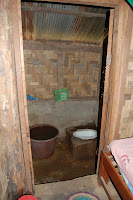
I think I posted way back about how much I love sticky rice. I think it goes back to one of my earliest childhood memories of my Aunt Elizabeth (yes, I was named after her) feeding me dollops of sticky rice rolled in sesame seeds for breakfast. I must have been 3 or 4, and my aunt had just arrived from Burma with her family and they were all living with us.
In Laos, sticky rice is an integral part of the diet and there is even sticky rice etiquette. I learned this, and some other secrets of Lao cuisine at a cooking class last Thursday. It was the best cooking class I have had so far, being set in the garden of the restaurant, a few kilometers outside of town. The owners have open air cooking pavilions set up over a large fish pond where the breeze takes away the heat and smoke of the wood-fired braziers (true Lao cooking – over a wood fire!) Laos cuisine has elements similar to Vietnamese and Cambodian, not too spicy, but with some nice curries. We made fish in banana leaves, a local stew with herbs I surely cannot find at home, and lemongrass stuffed with chicken and herbs. I am looking forward to trying the new dishes at home!
The day after the cooking class, I went for a 3 day mahout training camp. Mahout is the term for elephant driver, keeper or trainer, and the idea is to let tourists learn how to give commands and control the elephants. My sole purpose was to get up close and personal with the magnificent creatures for more than a photo op. I mean, how useful would the training skills be after the camp? (I can imagine adding to my resume under Other: “Elephant Control Skills”!)
I achieved my purpose, and spent hours atop various elephants, until my knees were rubbed raw by the brush bristle hairs on their massive heads. Some of the heads still bear the scars from knocking down trees in their logging days, as most of the elephants are retired or rescued from logging operations up north.
As for controlling the elephants, I didn’t have a chance. The mahouts explained that they make the elephant scared of them, in order to maintain control. They have a hammer-size stick with a curved nail-like piece on the end to dig into the elephant if it won’t obey – and of course using that thing is something I just won’t do! I think the elephants could sense that I would do them no harm, so when it was just me on top, they did whatever they pleased, which was mostly to eat. An average Asian elephant eats 300kg of plant material a day, so they are constantly stuffing things in their mouths. Since I spent hours watching them, I could spend pages writing about the amazing things they do with their trunks, and how nimbly they maneuver their massive bodies, but I’ll spare you. I’ll just say that if you ever get a chance to spend some quality time with an elephant, it’s worth it!
The photo below is of the top of an elephant's head so you can see what I mean about the the wiry hairs!

To let you all know of a change in plans, I will be staying in Laos until March 16 only, then I am off to Thailand. As much as I like Laos, my malaria meds are running out, and I am craving civilization. Still a few more adventures to be had!














